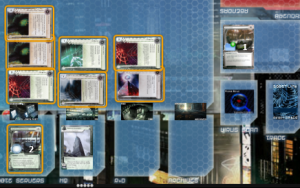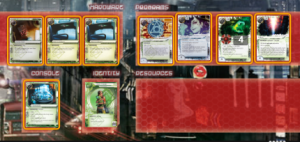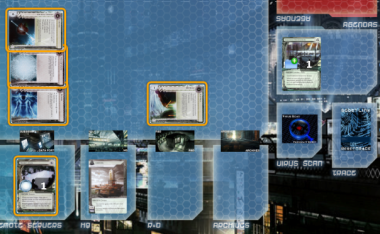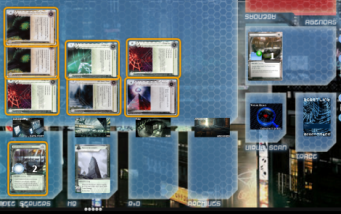Welcome to Corp hell.
In this article I’m going to give a primer on the scummiest, meanest, and cheesiest runner deck I have ever played. Interestingly though, it is actually very difficult to pilot well. Once you understand how to wield this black-market weapon, you will find that you win almost as many games by concession as you do by points.
Here is the list:
http://netrunner.meteor.com/decks/272iQmSCGTyqd9iWC
Siphon Noise (45 cards)
Noise: Hacker Extraordinaire
Event (12)
3 Account Siphon ···· ···· ····
3 Deja Vu
3 I’ve Had Worse
3 Sure Gamble
Hardware (2)
2 Vigil
Resource (8)
3 Data Leak Reversal
2 Joshua B.
3 Same Old Thing
Icebreaker (7)
2 Corroder
2 Crypsis
3 Knight
Program (16)
3 Datasucker
3 Gorman Drip v1 · · ·
2 Imp
3 Lamprey
2 Medium
3 Parasite
For many of you it will be clear that this deck is quite clearly a modernization of Steven Wooley and Sam Suied’s Anatomy of Anarchy deck, updated with Lamprey, Vigil, and I’ve Had Worse.
General Game-Plan: Don’t let the Corp play Netrunner. Do whatever you have to do to land an Account Siphon. Once you nail them with one, each successive Siphon will be easier, leading to a brutal snowball effect. Float all the tags. The deck only has 3 kinds of cards in it, Economy cards, Cards that land Siphons, and cards that lock the game down once the Corp is broke. Don’t show your intentions until absolutely necessary. Act like a regular Noise deck with a bad draw until you are ready to unleash your assault of terror (not a hard story to sell, since you will mulligan almost any hand that has no Siphon, which is about 80% of hands.)
Card Explanations:
Public Enemy #1
3 Account Siphon: This is your primary economy card, your primary denial tool, and the hallmark of the deck. Never shake tags, even against decks that you know have tag punishment. The best card against you is Closed Accounts, and the decline of Criminal has sent that card straight into everyone’s binders. Any time you can go for a 4-5 + credit siphon, slam it down. Make sure the Corp cannot rez assets to deny your money. Trash naked remotes before you go for it. If they protect their unrezzed econ assets, wait for the corp to rez them and go trash them after you Siphon and they can’t rez the ice (they usually won’t hold them unrezzed if they protect them.) If the Corp is REALLY wily and holds assets unrezzed for an extended period (perhaps a SanSan), you may have to wait until they are rich to hit the first Siphon, giving you the money to trash everything and go back in for another.
Cards that Land Siphons
2 Corroder – If HQ is guarded by a cheap binary barrier, this is your way in. Against a Criminal player, the Corp will often no-rez their HQ ice to play around Siphon. As Noise, there are a lot of factors that encourage the Corp to rez (Datasucker, Lamprey, and a more subtle point I will discuss later). You often don’t want to waste parasites on Ice walls and similar trash, and Wraparound is a popular card, so Corroder is a smart include. There are quite a few games and match-ups where you will just chuck these, but that’s usually because you’re smashing the Corp so hard that you don’t need them.
3 Knight – This is your cheap early-game guaranteed Siphon. If the Corp opens Ice-Ice-Hedge fund. You can credit, Knight, Host Knight on HQ, Siphon, for the most devastating runner opening in the game. Whether they rez or not, they get wrecked. You either get a 15 credit swing, or a smaller swing that 0’s them out (unless they have a Tollbooth or something else huge there, but this is not common, especially against Noise, and at least they are still broke in that case). This is also your (janky) answer to Architect and your (less janky) answer to Lotus Field. Paying 4 for Architect sucks, but if you are getting 10 back, it’s OK, and there is no deck-space for Mimic in here. Architect is usually on R&D anyway, and by the time you have to break there it you may have 30 credits. Efficient breakers are a crutch anyway :P.
2 Crypsis – This card helps against players who keep protecting HQ with unrezzed ice even after you are rich. It also lets you convert your riches into the win in the end-game. It’s also a virus, for what that’s worth. I’ve tried Eater here, and you are welcome to, but without Crypsis I’ve had some games slip through my fingers where I’m rich but I get locked out in the end-game. You also often ditch this guy early game and he’s smoother to get back with Déjà vu when you need him, since you can get something else back too.
3 Datasucker – This card encourages rezzes and enables blowout Parasite plays. In the late game you want 2 of these out to make Crypsis + Medium reasonably efficient for closing the game. This is probably the next best card to see in your opener after Account Siphon.
3 Parasite – This is your solution to cheap non-barriers on HQ, as well as R&D ice that the Corp manages to rez before you break them. If you have easy sucker counters, then hold your parasites for the surprise Siphon play, otherwise just slap them on HQ and let them eat away. Many players’ response to Noise Parasiting HQ is to play faster, establishing a remote right in the window where you plan to break them. This plays right into your hands.
Cards that abuse a Corp with no Money
3 Déjà vu – These usually either get back a Siphon or 2 Parasites, depending on the situation. Against open HQ turn 1, Siphon-Déjà vu-Siphon wins you the game. Disgustingly enough, open HQ turn one is not that uncommon of an opening against Noise. The ultimate feeling of runner justice is this sequence:
NEH player – Install SanSan, Sweeps, Ice R&D.
Noise – Trash Sansan, going to 0. Siphon-Déjà vu-Siphon, going to 16 credits.
NEH player (0 credits) – “Well this Astro is less good now…”
3 Same old thing – These are Account Siphon 7-9. Sometimes it is OK to play this when tagged as a credit drain, but if the Corp has somehow dug themselves out of the ditch, it can be better to wait until you can use it in the same turn. Some players will not even trash this when given the chance, which is a mistake, but we’ll take it.
2 Medium – This is your main late-game win condition, but you often will not need it. It is critical against Butchershop. They are very easy to get to 0 credits, and half of their ice does nothing to you (nice Data Raven). However, Traffic Accident is terrifying and once you get on top of this deck Medium helps you wrap up the game before they can fire the kill-shot. This is also your answer to a rezzed Architect or Lotus Field on R&D, since this deck cannot afford to pay money for single accesses of R&D.
3 Lamprey – When the Corp cannot rez on HQ, or has no ice there. This card keeps them on 0 and then takes their turn to purge it away. This is the best follow-up after you Siphon to 0 and the Corp clicks up to 3. It’s really nice that regular Noise also plays this card now, as it used to be a bit of a tell. This card also helps you force stingy players to rez on HQ in the early game, helping you get in for your first Siphon. Keep in mind that this card triggers before siphon, so if they have 5 or fewer credits you will get 2 fewer than you should, which is bummer. On the other hand, it helps 0 them out if they have more than that, so it’s OK.
3 Data Leak Reversal – The Corp will trash this. Just drop it down click 4 after you Siphon them and they will have to Credit Credit Trash. Noise with a running DLR is unacceptable and will close the game in archives very fast especially with Joshua B. If you are on game point and losing control of the game, you can also use this to get 2 mills that are hard to prevent, letting you steal games that you should lose.
2 Joshua B. – Similarly to DLR, the Corp will trash this card. Some players will feel the pressure and let this guy stand though, which is amazing for us. Dropping this and 2 DLRs in the same turn with the Corp on 0 credits is hilarious.
2 Vigil – Wooley’s original deck had Grimoire, and the Reina version had Deep Red. Vigil is perfect for this reincarnation of the deck. When the Corp is broke, it is impossible for them to keep their hand-size down, giving you 5-click turns for the rest of the game. This card also helps immensely against Butchershop, keeping your hand-size up and digging for your I’ve Had Worse.
Imagine you are a Corp with 0 credits staring down this board, and fight the urge to concede:
Economy
Most of your economy comes from Account Siphon, but these cards are here to get you the funds you need to land your first one.
3 Sure Gamble – Gives you the early game burst you need to kill unrezzed assets before you siphon. Also makes Knight less painful to use the first time.
3 Gorman Drip – Sometimes the Corp can duck your Siphon, leaving you both broke. This card gives you the edge as you both click your way out of the poor-house. Also, you can often cash these in for 8+ as the Corp is forced to Credit-Credit-Trash your tag-me resources.
2 Imp – Kills Crisium grid and pesky econ assets like Pad Campaign. I would like to run 3 of this, but I can’t find space, and sometimes it’s a dead card. 2 credits is not insignificant for this deck to pay. Imp also trashes meat damage operations, which can save your life.
3 I’ve Had Worse – Essential against meat damage decks and Personal Evolution. It cycles away in match-ups where you don’t need the protection. Here is one of my favorite sequences I’ve had with this card:
Jinteki RP turn 1 – Celebrity Gift showing Cortex lock as only ice. Ice HQ. (12 credits)
Me (Noise) – Datasucker – Run HQ. The Corp gives me a funny look and asks if I’m sure. I say yes and take 3 damage, discarding 2 IHW, drawing to 7 cards (including a Siphon). Click 3 Account Siphon, discarding another IHW (drawing another Siphon). Click 4 Account Siphon, leaving me with 24 credits and 2 cards and him with 0 credits. He never had more than 5 credits for the rest of the game. Sorry!
Obviously not realistic, but still a good story 😛
Conclusions:
This deck takes a lot of practice to play well. The deck gets much weaker once your opponent knows what’s going on, so you need to make sure it is too late for them to do anything about it once they are wise. That said, even if they know what you are doing, they still need to draw the right cards at the right time to stop you, and that’s even assuming they know the lines of play that beat you in the first place (which only very seasoned players will). I’ve won some hilarious games with this deck playing people for the 2nd time who triple Iced HQ and then lost because I’m Noise and they scored out too slowly.
The biggest question I get with this deck is why Noise instead of Reina (or even Whizzard or Quetzal). The obvious answer is to make for a better surprise, since the lines of play that beat standard Tier 1 Noise builds are terrible to take against this deck (open or lightly defended HQ and/or an early scoring remote). However, even if you ignore this advantage completely there is another great reason to pick Noise. Here is the underlying theory that motivates this choice:
Siphon Anarch wants to provoke rezzes on HQ to enable Parasite, inform the Siphon play, and prevent the Corp from ducking the Siphon by paying for Ice. The old counter to this style (especially against the Reina builds) was to hold your HQ ice unrezzed for as long as possible and use Jackson to dump your agendas so you can give up HQ accesses while you set up your defenses and economy. Noise puts alternative pressure on Jackson with his R&D trashes, forcing the Corp to hold their agendas in hand and therefore rez on HQ, playing into your plan. Additionally, Noise helps the Corp agenda flood once they are broke for the same reason, letting you cash in your Lamprey runs for points. Finally, this deck can sometimes run out of gas if you are really unlucky on accesses and cant find more siphon recursion or denial cards to keep the lock on. When that happens, it usually means the game is waiting for you in archives :).
I played this deck to great success in the last Mead Hall League, losing only a handful of times over a 10 week league. I told everyone that each week I was going to mix up which Noise I was bringing, and then just brought this one nearly every week. I felt like it was OK to write up the deck here, since I think it has terrorized enough people and I should probably stop bringing it.
I don’t think this is a Tier 1 caliber deck, but it’s hard to say since it is pretty unexplored. Give it a try and see what you think! Piloting it may require a big mindset change, so be ready to struggle your first few games while you get the hang of it. Your opponent will be struggling once you do…
…or you can just throw this down any time someone complains that Noise is non-interactive.
I didn’t realize it until now, but I think one of the money-sounds in the background is the same sound OCTGN makes when the Corp clicks for credits. Extra appropriate 🙂





